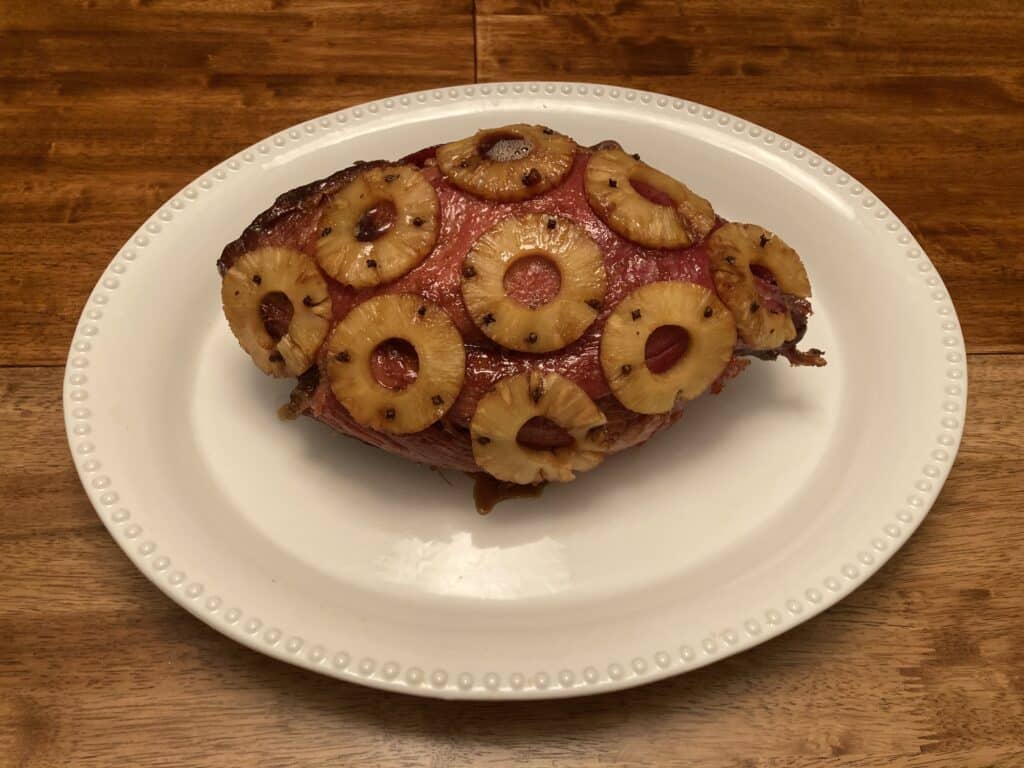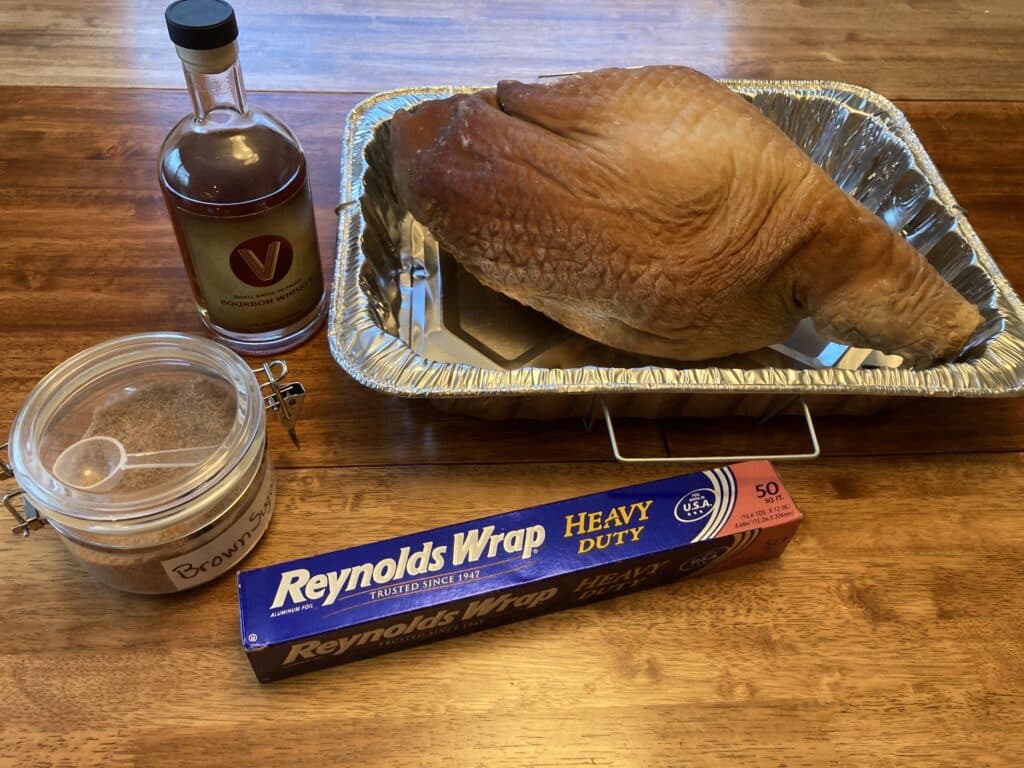A few weeks before Thanksgiving, I headed out one morning to find a country ham for my cousin Tommy, who lives in northern West Virginia where grocery stores don’t generally sell them. The best country ham purveyors are concentrated mainly in Kentucky, Tennessee and Virginia.
I waited until Hopkinsville’s Food Giant marked down the price of their Clifty Farms hams. When the meat manager said he was just about selling them at his cost for $2.49 a pound, I bought three. One for Tommy. One for my friend Janet in North Carolina. And one for my family.
I cook two hams a year — at Thanksgiving and Christmas. Increasingly, I’m coaxing others to learn how to bake country hams, which are so superior to city hams that I wonder why anyone bothers with the latter for special occasions. Country hams have a depth of flavor and saltiness that is achieved through a months-long curing process. They are cured slowly and cooked slowly.

It didn’t take much to convince my cousin that he ought to try a ham for the holidays. Our grandfather cured hams for the family, and Tommy still remembered receiving them by special delivery 50 years ago.
Tommy and I have worked out a trade that we both appreciate. I send him country hams. He sends me pepperoni rolls from Fairmont, West Virginia. Believe me, you can’t get these type of pepperoni rolls in Kentucky. They come from bakeries established decades ago by Italian families.
- SUBSCRIBE: Sign up for our newsletters
As much as I love country hams for holidays and big gatherings, I almost suspended the ritual during the first year of the pandemic — when the virus seemed to turn everything upside down or inside out. That year I told myself I wasn’t going to cook anything special for Thanksgiving or Christmas. Might as well break from tradition at the end of a bizarre, historic year, I decided.
The group of friends who usually come at Christmastime wouldn’t be here for shrimp, country ham and Derby pie. We wouldn’t be drinking IPAs and Old Fashioned cocktails in my packed, loud kitchen, and our time with family would be seriously limited.
In my mind, 2020 was the year to pass on kitchen duty. Let someone else do the cooking. I wasn’t craving anything. Couldn’t I just spend that time reading a book or binge-watching something on Netflix? I even wrote an article for Hoptown Chronicle with a list of local, independent restaurants that could fill the void with carry-out dishes for people like me who didn’t feel very Christmasy.
Then I got sucked into a conversation about country hams — the most glorious, nostalgia-laden food of a Southern Christmas buffet.
- RELATED: 50 years ago, neighbors and Pennyrile Electric came to the rescue and saved their Christmas dinner
It all started when Julia Hunter, who is Hoptown Chronicle’s engagement editor, asked me where to call for a good ham that could be shipped to her house in Madison, Wisconsin. Julia lived in Hopkinsville from 2007 to 2010, when she and I both worked for the New Era. Her first year at the paper, I invited Julia to our house for Thanksgiving and she said she’d be there if I was serving country ham. I was. Several years later, when she came back for a visit at Christmas, I sent her away with half a ham that traveled through several states before she made her final destination around the New Year.
When Julia decided she would bake her own ham for the first time, I pointed her to the Cadillac of country hams purveyors, Newsom’s in downtown Princeton, Kentucky. She placed her order right away, and then needed instructions, which is where I came in.
I’ve been baking country hams since the mid-1990s. My process involves bourbon and brown sugar — and a lot of patience. I don’t have a recipe. It’s more like a kitchen narrative in three acts. Sometimes there is drama, like the year a chemical reaction between the sugar and alcohol caused a small explosion that blew open the oven door with a loud “bang!”
A country ham takes time. It’s a commitment.
There are benefits beyond the salty, tender meat. There’s the aroma that fills the house and induces memories of holidays past. I learned to appreciate the heavy scent of a ham’s smoked sweetness in the 1970s, when an excellent Hopkinsville cook named Rosie Lee Smith, who worked for my parents, baked a ham every Christmas when I was in high school. Rosie Lee’s ham lasted for more than a week, and we never seemed to worry about spoilage. A good, cured ham doesn’t go bad easily. It usually lingers into the New Year.
So after I got over my grumpiness heading into Christmas 2020, I decided I couldn’t pass on a country ham, not even in a pandemic. Or maybe in spite of it. A week before Christmas I drove over to Food Giant and picked out a 14-pound Clifty Farms beauty. I didn’t plan well enough to get over to Princeton for a ham that year. But even a budget country ham is far and away better than a city ham.
Here’s how it’s done:
Baked Country Ham
What you’ll need:
A country ham (good size is 13 to 16 pounds)
An extra large disposable roasting pan
Plenty of aluminum foil
Brown sugar
Bourbon
A can of pineapple rings
Whole cloves
Prep time: 18 to 24 hours
Cook time: 5 hrs 40 min to 6 hrs 40 min

Instructions:
I usually soak a ham for 18 to 24 hours in cold water (changing the water two or three times) to pull out some of the salt. But if you don’t have time to soak the ham, it’s OK.
Preheat oven to 375 degrees. Use a very large disposable roasting pan. Put the ham in the pan, dump two cups of brown sugar on top and rub the sugar into the meat a little. A lot of the sugar will fall into the bottom of the pan; that’s fine. Pour 1 cup cheap bourbon over the ham. Add 1 cup water to the bottom of the pan
Now use lots of aluminum foil and seal up the ham. You want a tight seal.
Bake the ham for one hour. Lower heat to 275 degrees and cook for an additional 20 minutes per pound. (So, if you have a 15-pound ham, you’re looking at six hours in the oven, then three to four additional hours for cool-down and final prep.)
If you hear what sounds like little explosions in the oven when the ham is cooking, don’t worry. It’s just a reaction between the sugar and alcohol. It won’t hurt anything.
When the baking time ends, turn off the oven and leave the ham in there for a couple of hours. Remove ham from oven and let is rest, sealed, on top of the stove another hour, then remove the foil. When it’s cool enough to handle, lift the ham out of the pan and put it on a surface where you can work on it. I usually take a baking sheet and cover it with some foil and put the ham on that.
Begin to peel away the rind and the layer of fat on top of the meat. Once you’ve done that, transfer the ham to an oven-proof dish, like a large meat platter.
Now you need one can of pineapple rings, more brown sugar and cloves (not ground cloves, but the whole cloves that look like tiny nails). Pour off 1/2 cup of juice from pineapple can and mix that with 1 1/2 cups of brown sugar to make a paste. Spread the paste on the ham. Take several pineapple rings and place them on the ham, using a few cloves like nails to attach them.
Put the ham back in the oven and bake 20 minutes at 350 degrees.
The last step with pineapples is mostly for appearance. You can skip that if you want. But you should at least do the brown sugar paste and warm it in the oven at 350 degrees.
You can slice the ham after it has cooled.
Enjoy.
Jennifer P. Brown is co-founder, publisher and editor of Hoptown Chronicle. You can reach her at editor@hoptownchronicle.org. Brown was a reporter and editor at the Kentucky New Era, where she worked for 30 years. She is a co-chair of the national advisory board to the Institute for Rural Journalism and Community Issues, governing board past president for the Kentucky Historical Society, and co-founder of the Kentucky Open Government Coalition. She serves on the Hopkinsville History Foundation's board.





